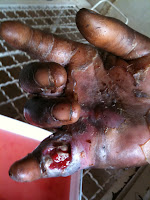Post conflict Sierra Leone. That is how it is still
categorized 7 years after the last of the UN peacekeepers have left; many
agencies and companies will pay you an extra stipend for coming to Sierra
Leone, so I am told. But in the ‘town’ of Mokanji, southeastern Sierra Leone
and in the heart of rutile and bauxite mining lands, at least on the surface, the
conflicts seem to be confined to the water wells and pumps where some older
kids feel the need to ‘flog’ a smaller child in line to fetch water or under
the plum tree where 5 kids battle for one or two juicy plums that was knocked
down after 30 minutes of stone throwing or ‘stoning’. But in a society that still holds on to
primitive farming techniques and venturing into the ‘bush’ for most necessities,
cuts, lacerations and puncture wounds are a daily occurrence and often lead to
major infections and even debilitating complications.
Once the word got out that ‘pumwae doctors’ (not sure how I
feel about being referred to as ‘white’ although on a few occasions I have
wished I was, but that will be for another post) were in town, they seemed to
come out of the woodwork. Two week old machete wounds with gangrene, month old
wounds with frozen joints and contractures and more than one injection site
abscess from local practitioners whose answer to all maladies involve a ‘shot’.
They all had the same story, “I having drinking the potion that the local
medicine man has been giving me but I not getting better”. Or worse, “if I go
the Freetown (the capital city) they will just amputate” The exact truth of
this is unclear but I am sure it is somewhere in the middle with someone who
went to the capital and ended up getting an amputation and the family’s
reluctance to come up with the money needed to pay for the cost of transportation
to the city.
It was our second week in Mokanji and my pregnant, yet eager
and very OCD, wife decided to tackle and inventory the ‘Men's Ward’. For those
who are not familiar with this place (and that would be all of you), it is part
of the building that will eventually be the Men’s Ward and where most
everything is stored, medical and otherwise, and we were eager to get a handle
on what kind of supplies we had on hand. And that is where I discovered the
nearly 500 single use packs of …that’s right…Surgilube, that very nectar of the
Operating Room, that essence of sterility, that bacteriostatic potion that has saved
the reputation of many a wayward surgeon.

Wound care has taken on a whole new dimension in this
‘rustic’ setting. Cleaning and keeping them clean is a monumentous task where
‘keep it clean and dry’ is not only easier said than done, it is often lost in translation.
It is cost prohibitive and logistically impossible to do daily dressing changes,
and semi-sterile conditions to do dressing changes, well it only exists in my
dreams. So… Surgilube to the rescue.
Soak and thoroughly clean the wound as best you can and
lather on the Surgilube. Apply dressing and tell the patient to come back in 3
days. It is a beautiful sight to see a clean wound on the first dressing change
and granulating tissue with the second dressing change on a wound that was all
dead tissue and pouring with pus just a week ago.
Two inch injection site abscess with tunneling? No Iodoform
gauze? No problem. Pack every three to four days with gauze soaked in… you
guessed it…Surgilube. Three to six weeks and it is all filled in. Ten days of
PO antibiotics doesn’t hurt either.
As my fame spreads to nearby villages, there is a down
side...I am running low on Surgilube.
On a more serious note, please be praying for a 4 month old
baby girl I am treating with a huge abscess from an injection to the right
buttock (administered by local untrained ‘practitioner’ and an inappropriate
injection site for a 4 month old) that was initially treated at a hospital 2
hours away but asked to find continuing wound care closer to home.
 |
| 1 month old infected machete wound |
.jpg) |
One month later, thanks to a course of oral
antibiotics, frequent dressing
changes and Surgilube |
This is just one example of how a round of oral antibiotics and frequent dressing changes can make a difference in a wound. While he has limited range of motion with 3 fingers, at least he still has his fingers and his hand!

.jpg)